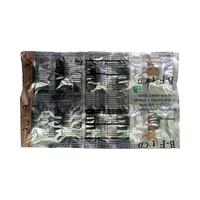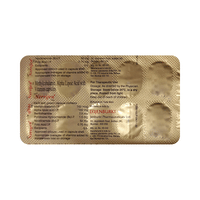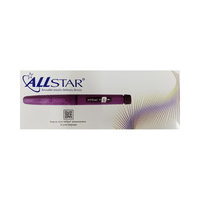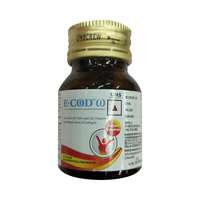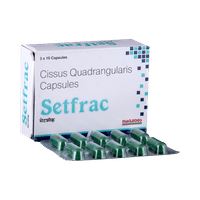Rs.152for 1 strip(s) (10 tablets each)
food interaction for Sgltr Tablet
alcohol interaction for Sgltr Tablet
pregnancy interaction for Sgltr Tablet
lactation interaction for Sgltr Tablet
food
alcohol
pregnancy
lactation
Sgltr Tablet may be taken with or without food, but it is better to take it at a fixed time.
None
None
CAUTION
It is unsafe to consume alcohol with Sgltr Tablet.
UNSAFE
Sgltr Tablet may be unsafe to use during pregnancy. Although there are limited studies in humans, animal studies have shown harmful effects on the developing baby. Your doctor will weigh the benefits and any potential risks before prescribing it to you. Please consult your doctor.
CONSULT YOUR DOCTOR
Sgltr Tablet is probably unsafe to use during breastfeeding. Limited human data suggests that the drug may pass into the breastmilk and harm the baby.
CONSULT YOUR DOCTOR
SALT INFORMATION FOR Sgltr 100mg Tablet
Remogliflozin Etabonate(100mg)
Sgltr tablet uses
{med_name} is used in the treatment of type 2 diabetes mellitus.
How sgltr tablet works
Sgltr Tablet is an anti-diabetic medication. It works by removing excess sugar from your body through urine.
Common side effects of sgltr tablet
Nausea, Diarrhea, Constipation, Hypoglycemia (low blood glucose level), Dyslipidemia, Hypotension (low blood pressure), Urinary tract infection, Fever, Cough, Headache
SUBSTITUTES FOR Sgltr Tablet
5 Substitutes
5 Substitutes
Sorted By
 Rs. 220.30save 3% more per Tablet
Rs. 220.30save 3% more per Tablet Rs. 141.09save 7% more per Tablet
Rs. 141.09save 7% more per Tablet Rs. 220.30save 7% more per Tablet
Rs. 220.30save 7% more per Tablet Rs. 156.55pay 3% more per Tablet
Rs. 156.55pay 3% more per Tablet Rs. 124.69save 21% more per Tablet
Rs. 124.69save 21% more per Tablet
Expert advice FOR Sgltr Tablet
- It may cause your body to lose too much fluid (dehydration) or you may urinate more often. Drink plenty of water and stay hydrated.
- It can cause genital fungal and/or urinary tract infections (UTIs) in both females and males, so practice good hygiene.
- It may cause hypoglycemia (low blood sugar level) when used with other antidiabetic medicines, alcohol or if you delay or miss a meal.
- Always carry some sugary food or fruit juice with you in case you experience hypoglycemia symptoms such as cold sweats, cool pale skin, tremor and anxiety.
- Inform your doctor immediately if you experience constant dizziness, joint pain, cold-like symptoms or unexplained nausea/vomiting.
- Monitor your blood sugar regularly while taking this medicine.
- Remogliflozin Etabonate is used alone or together with other diabetes medicines to control blood sugar and avoid long-term complications.
- It also reduces the risk of heart attack, heart failure or other cardiovascular events.
- You should continue to exercise regularly, eat a healthy diet, and take your other diabetes medicines (if prescribed) along with Remogliflozin Etabonate.
- Remogliflozin Etabonate may also reduce weight and blood pressure.
- It may cause your body to lose too much fluid (dehydration) or you may urinate more often. Drink plenty of water and stay hydrated.
- It can cause genital fungal and/or urinary tract infections (UTIs) in both females and males, so practice good hygiene.
- It may cause hypoglycemia (low blood sugar level) when used with other antidiabetic medicines, alcohol or if you delay or miss a meal.
- Always carry some sugary food or fruit juice with you in case you experience hypoglycemia symptoms such as cold sweats, cool pale skin, tremor and anxiety.
- Inform your doctor immediately if you experience constant dizziness, joint pain, cold-like symptoms or unexplained nausea/vomiting.
- Monitor your blood sugar regularly while taking this medicine.
Frequently asked questions FOR Sgltr 100mg Tablet
Remogliflozin Etabonate
Q. Is Sgltr Tablet effective?
Sgltr Tablet is effective if used in the dose and duration advised by your doctor. Do not stop taking it even if you see improvement in your condition. If you stop using Sgltr Tablet too early, the symptoms may return or worsen.
Q. What is the recommended method of taking Sgltr Tablet?
Take the recommended dose advised by the doctor. Sgltr Tablet may be taken with or without food. It should be swallowed whole with water, preferably at the same time each day. For best results, it is important to stay on a diet and exercise program as directed by your doctor.
Q. Can Sgltr Tablet be used with other diabetes medicine?
Yes, Sgltr Tablet can be used alone or in combination with other diabetes medicines. However, along with medicines, proper diet and exercise should be followed.














